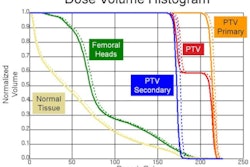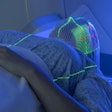The American Society for Radiation Oncology (ASTRO) and the American College of Radiology (ACR) have jointly issued practice guidelines for image-guided radiation therapy and for the performance of stereotactic body radiation therapy.
The guidelines offer definitions of the two technologies, detail the professional responsibilities for healthcare professionals administering them, and provide guidance on quality assurance. Both sets of guidelines were published in the February 1 issue of the International Journal of Radiation Oncology, Biology, Physics (2010, Vol. 76:2, pp. 319-325).
Image-guided radiation therapy
ASTRO and the ACR define image-guided radiation therapy (IGRT) as a procedure that refines the delivery of therapeutic radiation by applying image-based target relocalization to allow proper patient repositioning to ensure accurate treatment and minimize the volume of normal tissue exposed to ionizing radiation. It is separate from the actual delivery of radiation therapy, and can be performed to enhance both 3D conformal radiation therapy or intensity-modulated radiation therapy.
An IGRT system typically includes software with the capacity to fuse acquired images with the expected image appearance and to calculate the vector displacement in 3D space of the actual target location from the expected location. X-, y-, and z-axis displacements are corrected by moving the treatment table on which a patient is immobilized.
The guidelines define in detail the qualifications and responsibilities of the radiation oncologist, medical physicist, medical dosimetrist, and radiation therapist with respect to IGRT.
The guidelines recommend using fiducial markers as surrogates to target areas when a target is not clearly visible and bony anatomy is insufficient for adequate target alignment. They address methods to account for both intrafraction and interfraction organ motion, as well as target definition of organs in motion. Image acquisition and treatment accuracy and reproducibility issues are also discussed.
Lead author Dr. Louis Potters, of the department of radiation medicine of Long Island Jewish Medical Center in New Hyde Park, NY, and the 13 other members of the guidelines committee also recommend use of immobilization devices and confirming treatment positions on at least a weekly basis for each patient undergoing a course of treatment.
Noting that IGRT uses specialized computer techniques to register image datasets to more precisely monitor and correct setup deviations, the committee stated that treatment and image-guidance system verification must be added to traditional quality assurance procedures. Quality assurance tests must start with CT simulation and extend through treatment planning, IGRT positioning, and the treatment itself.
Stereotactic body radiation therapy
ASTRO and the ACR define stereotactic body radiation therapy (SBRT) as an external-beam radiation therapy method used to precisely deliver a high dose of radiation to an extracranial target within the body, using either a single dose or a small number of fractions. It requires significantly improved delivery precision over that required for conventional radiotherapy and can be applied using noninvasive or minimally invasive stereotactic localization and radiation delivery techniques.
The guidelines define the qualifications and responsibilities of the radiation oncologist, medical physicist, medical dosimetrist, and radiation therapist with respect to SBRT, emphasizing that the SBRT process requires a coordinated team effort by all participants.
The guidelines committee, with Potters as lead author, noted that strict protocol must be adhered to regarding quality control, simulation, and treatment. Because SBRT quality assurance must guarantee that both the image-guided system and the treatment delivery system are functioning within acceptable tolerances, they must be tested together. Ancillary instrumentation used to determine stereotactic coordinates of the target and immobilization devices should be routinely tested.
The guidelines discuss issues pertaining to quality control for both the images and the treatment planning system. Tolerance for radiation targeting accuracy needs to be determined for each different organ system in each department performing the SBRT by actual measurement of organ motion and setup uncertainty.
The committee also warned that any software, electrical, or mechanical malfunctions that disturb the connection between the image-guidance system and the treatment delivery system can produce erroneous results that are not easily detected.
By Cynthia E. Keen
AuntMinnie.com staff writer
January 29, 2010
Related Reading
New York Times article details radiation therapy errors, January 26, 2010
Adaptive radiation therapy monitors tumor change, December 25, 2009
ASTRO publishes IMRT guidelines, August 7, 2009
On-board imaging adds accuracy to IMRT for prostate, June 25, 2008
Copyright © 2010 AuntMinnie.com



















